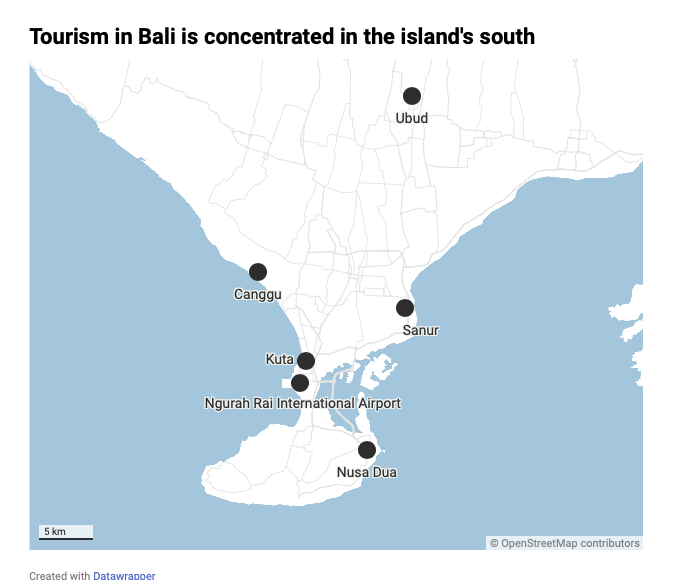Bali boasts world-famous beach clubs, surf breaks and ancient Hindu temples.
The problem is, you often have to battle traffic to get to them.
The back of motorbike helmets, humidity and exhaust fumes might not be posted to Instagram but are as common in Bali as the island’s famed suckling pig dish, babi guling.
Less than 40 kilometres from Ngurah Rai International Airport are Ubud’s terraced rice paddies — and it generally takes upwards of two hours to get there.

Canggu, a hotspot for party people in recent years, is a mere 20 kilometres from the airport.
But getting there, via other tourist areas Kuta and Seminyak, typically takes 90 minutes — or longer.
Authorities want that to change.
Last month, Bali’s provincial government announced US$20 billion ($29 billion) worth of investment had been secured for a rail project dubbed the Bali Subway.
It’s aimed at providing fast links between the airport and popular tourist destinations.
The head of Bali’s Department of Transportation, I Gde Wayan Samsi, told the ABC that phase one of the project was slated for completion by 2027.

First stop: Kuta beach
Indonesia was the most popular overseas destination for Australians in 2023 with about 1.37 million heading there — many of whom went to Bali.
As construction for tourism on the island has boomed, public infrastructure has not kept up.
Balinese local Ketut Gunawan commutes by motorbike and said the island’s traffic had become worse over the past five years.
Mr Gunawan recounted a time when he did not move in Canggu traffic for an entire hour.
“Since COVID the number of vehicles owned by either locals or tourists has exploded tremendously.”
The first leg of the Bali Subway would link the airport to areas to its immediate north including Kuta, Seminyak and Canggu.

The second would go to the luxury resorts of Nusa Dua in the south-east of the island.
A third would link it to Sanur, north-east of the airport, and a final, fourth phase would connect Ngurah Rai directly to Ubud.
I Putu Winastra is the head of ASITA Bali, an industry body representing travel companies.
He told the ABC he was enthusiastic about Bali Subway, which would allow people to avoid congested areas.

In turn, this would “help shift negative perceptions about Bali itself” such as that there are too many tourists, he said.
“Bali is not just Kuta, Seminyak, Canggu.
Locals unlikely to benefit from train
Director of the Jakarta-based Rujak Centre for Urban Studies, Elisa Sutanudjaja, said she was sceptical of the project, including its ambitious timeline given it would require boring underground in densely populated south Bali.

Bali’s acting governor Sang Made Mahendra Jaya said the needs of the local community should be considered in constructing the subway and that its development should provide jobs to as many Balinese workers as possible.
“Tickets must not be expensive for the local Balinese,” he said, as quoted by the Indonesian news agency Antara.
“It must be subsidised by the company.”
But Ms Sutanudjaja said given the train line was not proposed to go to Denpasar, where most Indonesian commuters in south Bali live, it would unlikely help locals.
She added the main purpose of public transportation was to help urban mobility and that reducing congestion was generally not an immediate result.
“You need a ‘push and pull’ policy. So you’ve already provided the means, the transportation — the bus, the train — but you also need like a stick and carrot.
“You need to push people using a private vehicle to use the public transportation.”

Putu Rumawan Salain, an architecture lecturer from Udayana University in Bali, told Benar News there were “many problems” with the project.
Both Ms Sutanudjaja and Dr Salain expressed concern about the fact that no feasibility study had yet been produced.
Mr Samsi from Bali’s transport department said a feasibility study was underway, and acknowledged that funding the project was an ongoing challenge.
“We don’t have the money,” he said.
